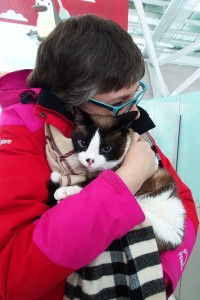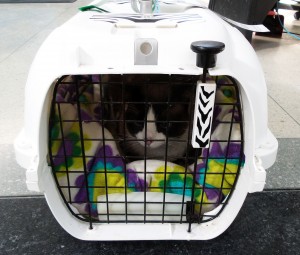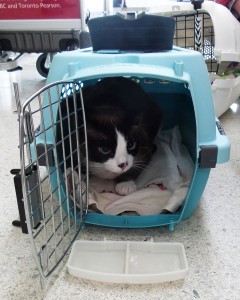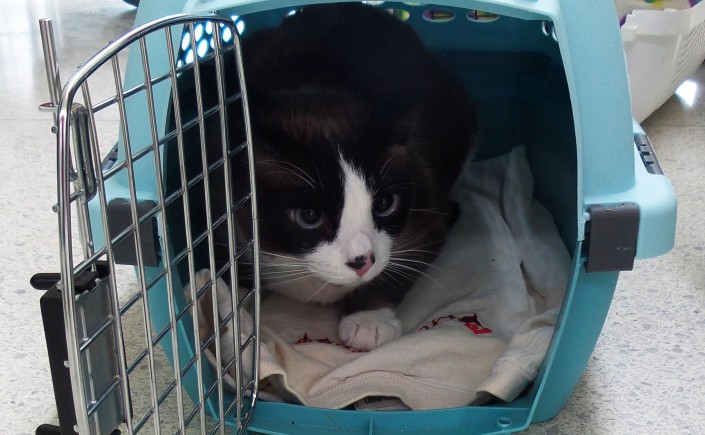This post will help you if your humans are considering a move – by K.I. Borrowman
A letter regarding moving:
Dear Baker,
My humans recently decided to move to China. I have never traveled before, and I have no idea what to expect. My dilemma is, do I move with them, or insist that they find some kindly elderly human to “foster” me while I await their return?
Yours,
Torn Between Two Humans
Advertisement: Click here to play Spot the Kitty
Dear Torn,
Well, this is an unusual dilemma that most cats will never face! But my friends and I at Spot the Kitty HQ have all moved a time or two, and we can assure you that it is, while unpleasant, doable for most cats.
First, your humans have to determine whether you are hardy enough to endure a long flight. For example, our colleague, Scribbles, took to drooling every time she was put in her cat carrier. Her humans realized that if she was in the carrier for too long, i.e. long enough to get to China or other random far-off place, she might drool herself to death. They decided on the elderly-person-foster-care option instead. But our other colleague, Pixie, has just made a move to China and is more than happy to share his experience with you.

This is Pixie at Toronto Pearson Airport. As you can see, he is not scratching anybody’s eyes out. Nor does he look especially thrilled about the trip ahead of him.
- Regulations:
Have your humans check and double-check the regulations for moving you to a foreign country. Nine times out of ten, you will need all kinds of paperwork, such as a rabies certificate from your vet stating that you are up-to-date on your rabies shots, a certificate of health, a chip, and an import certificate for your new country. Some countries have additional requirements. For example, to move to Hong Kong, you must travel as “cargo”. If you move to Beijing or Shanghai, you will be quarantined for up to 30 days in your carrier at the airport! If you think the country you are moving to has difficult regulations, I’d recommend having your humans hire a relocation company. Make sure you check the company’s customer feedback, as some companies are more reliable than others.
- Airlines:
Some allow pets to travel in the cabin and others do not. Some airplanes have small heated and pressurised areas in the hold for a few pets to travel in comfort. Make sure your humans check and, yes, double-check the airline’s method of pet transport and notify the airline several days before your flight that you will be traveling with them.
- Carrier:
If you are travelling in the cabin, you will be expected to stay in your carrier under the seat in front of your human for the entire flight. Make sure your humans have a soft carrier that can fit under the seat. You will need to check the airline’s size restrictions. If you plan to travel in the hold, international airline regulations require you to be in a sturdy hard-sided, leak-proof carrier with ventilation holes on all sides. Collapsible wire carriers cannot be used. You must be able to stand up, turn around, and lie down comfortably in your carrier. Have your humans pick up stickers at your vet that say “live animal” and arrows pointing up, or write and draw these important tips on your carrier with a big permanent marker. You don’t want any disgruntled airline employee tossing you around or putting you upside down! Finally, make sure you have a comfortable, warm blanket in your carrier. Even the heated area of the hold can be chilly during a long flight.

This is Pixie’s carrier for travelling in the hold. On this flight, Pixie was told he had to travel as checked luggage due to the airplane’s space restraints.

This is Pixie in his carrier for traveling in the cabin. This carrier is small enough to fit under the seat in front of Pixie’s humans. A soft carrier can also be used for cabin travel.
- Pre-flight Preparations:
You shouldn’t eat or drink just before a long flight, as you might get a tummy-ache, but do have a drink of water about an hour before your flight. You won’t be able to eat, drink, or use the litter during your flight. If you have never travelled before, have your humans drive you around in your pet carrier as often as possible in the weeks leading up to the flight so you will be used to the sensation of being on the move. Pixie’s human got some herbal wipes at his vet that, when used to wipe down the inside of the carrier, produced a nice calming scent. Lance was hesitant to use his carrier, so his humans tossed a handful of yummy cat treats in there every day leading up to the flight until he associated cat carrier with treats.
However, despite preparations, you may still dread the actual flight. No matter how nervous you feel, I highly recommend that you DO NOT use any sedatives. The airline flight attendant on Pixie’s flight told our humans a horrifying story about a cat who died during a flight because of ingesting too high a dose of sedatives. But don’t worry; if you have prepared properly for your flight, you will be relaxed and likely sleep through the entire ordeal.
To make your transition to your new home more tolerable, make sure your humans pack absolutely all of your favourite toy mice, food, dishes, placemat, blanket, bed, kitty castle, empty boxes, paper balls, litter of choice, rubber balls, and other things from home to help you settle in once you reach your destination. Tell them they can leave the dog and the cat clothing behind, though.
- Settling in:
Once you reach your new home, you will want to have a bowl of your favourite food, some fresh water, and a box of your regular litter available to you immediately. You will want to spend several minutes exploring and sniffing your new home before you are expected to cuddle. In fact, you may feel angry at your humans for putting you through the entire ordeal and may not want to cuddle for several minutes, until you forget all about it and feel comfortable in your new surroundings. This is entirely normal. Don’t feel bad if you feel the urge to bite and scratch for the first few hours. Take advantage of the situation to get a lot of yummy treats as your humans will most likely feel guilty for what they have done.

